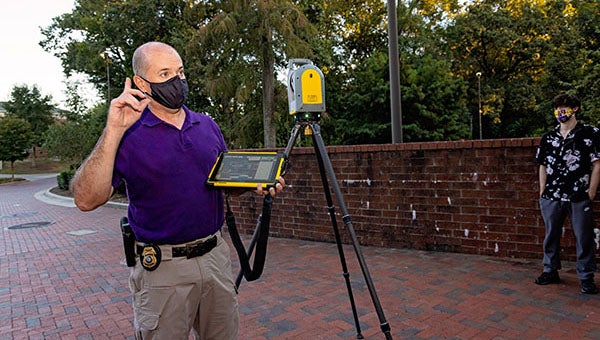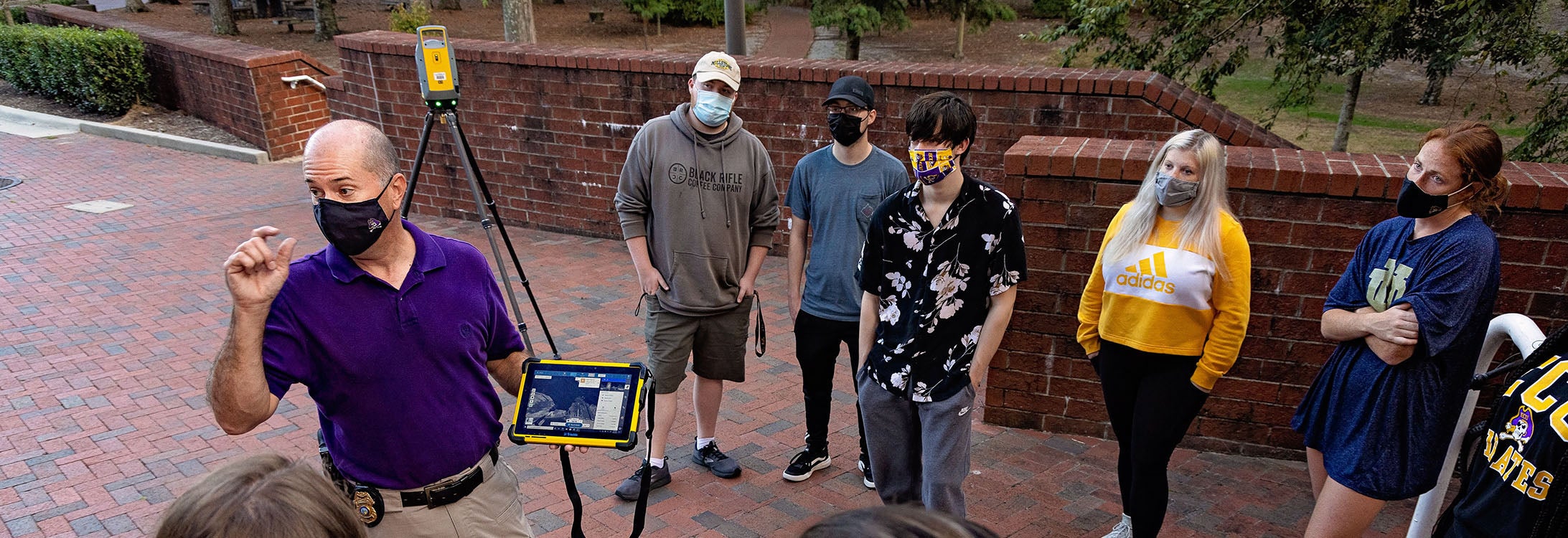FORENSIC LESSONS IN 3D
ECU criminal justice students use cutting-edge technology to learn about forensics
Criminal justice students at East Carolina University are the first students in North Carolina, and the surrounding states of Virginia and Florida, to use a 3D laser scanner — the latest in the investigative field — to analyze crime and crash scenes.
Over the summer, ECU’s Department of Criminal Justice purchased and trained select faculty on a Trimble X7 3D laser scanner, and its accompanying Trimble T10 tablet, the latest in crime scene scanning equipment.
The scanner is being used for the first time this fall in two criminal justice lab courses — crime scene investigation, and forensic impressions and markings. One of the classes is taught by Robert Evans, a long-standing, part-time instructor and full-time agent with the North Carolina State Bureau of Investigation.
These classes give students an opportunity to view demonstrations and perform various crime scene processing techniques ranging from fingerprinting and casting impressions to photographing and sketching. Now, they have another tool in their belts.
“The addition of a 3D scanner to our list of available demonstrations will prepare students for the future of law enforcement investigations. Students have the opportunity to utilize cutting-edge crime scene investigation technology and gain even more of a real-world forensic experience,” Evans said.
The scanner records measurements using millions of data points and photographs every detail of a crime or crash scene. In his class, Evans shows students how to operate the instrument, how the images and data are processed, and how those images and data are then used in a courtroom.

Evans discusses and shows students the resulting 3D image just taken by the new laser scanner on the Trimble T10 tablet.
“This 3D scanner automatically takes and links pictures with every data point for easy reference and analysis away from the scene,” Evans said. “Modern technological advances have allowed these scanners to be extremely efficient and quick when it comes to scanning. Most 360-degree scans take around two minutes each. In addition, multiple scans are automatically stitched together by the software, allowing for large, multiple room scans to be seamlessly viewed on a computer.”
Sophia Farrow, a biology major pursuing a forensic science minor and a certificate in forensic anthropology, said she and others in Evans’ class are benefiting from using the latest technology in the field.

The laser scanner may be used at crime scenes or automobile crashes to recreate the 3D environment.
“I am fortunate to have the opportunity to work with the scanner and learn how it operates. What I find most interesting is its ability to collect data, photos and videos in such a short period of time,” she said. “This technology shows how far we have progressed and makes me curious for what crime scene investigation will be like in the future.”
Farrow is on ECU’s pre-medicine track and works as an advanced emergency medical technician for Dare County Emergency Medical Services. She hopes to become an emergency medicine physician and remain in eastern North Carolina to serve the community.
Another student in Evans’ class, Kaylyn Aguayo, said, “East Carolina University is challenging the skills and knowledge I learn in my courses. I truly believe this type of equipment changes the future for law enforcement officers.”
Aguayo is a biology major with an emphasis in molecular and cell biology and is minoring in forensic science. She wants to attend medical school and pursue a residency in forensic pathology.
Evans said many law enforcement agencies across the state of North Carolina and the country are beginning to use 3D scanning technology to document complex crime scenes. He said the N.C. State Highway Patrol and the SBI are in the process of purchasing Trimble 3D scanners like the one acquired by ECU.
ECU’s purchase was made possible by a combination of funds, including a grant to Dr. Heidi S. Bonner, associate professor and chair of criminal justice, and the department’s priority fund, which is largely supported by criminal justice advisory board members.
“It was their donations that helped make this purchase a reality,” Bonner said. “We are excited we have a new opportunity for forensic science students to get additional real-world exposure to tools used in the field.”

ECU students in the forensic lab course learn how to use cutting-edge crime scene investigation technology.
